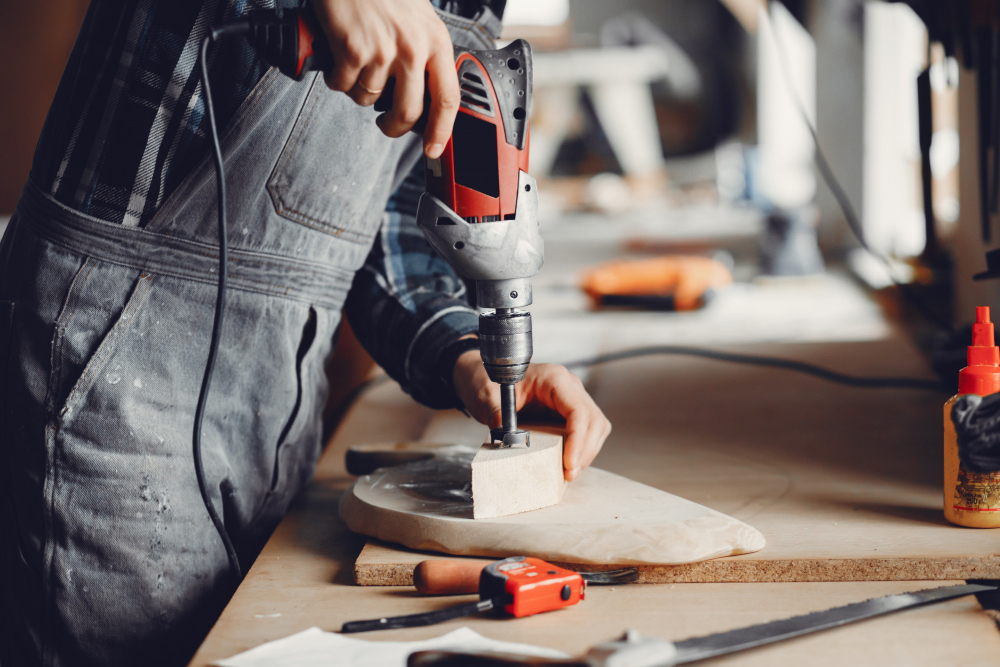Most Important Drill Hacks You Need to Know

Introduction:
Drills are an essential tool for any DIY enthusiast or professional handyman. They come in different shapes, sizes, and types, from cordless to corded, hammer drills to impact drivers, and more. The uses of a drill are numerous, from drilling holes, driving screws, mixing paint, and more. In this blog post, we will share some drill hacks that can make your work easier, faster, and more efficient. These hacks cover various topics, from safety tips to choosing the right drill bit, proper drilling techniques, and alternative uses of drills. So, let's dive in and discover some drill hacks that can take your DIY game to the next level.
Safety First:
Before we dive into the hacks, it's essential to emphasize the importance of safety when working with drills. Power tools can be dangerous, and it's essential to take the necessary precautions to prevent accidents. Here are some safety tips to keep in mind:
- Always wear eye protection, such as safety glasses or goggles, to prevent eye injuries from flying debris or dust.
- Use the right drill bit for the job and ensure that it's securely attached to the drill.
- Keep the work area clean and organized to prevent tripping hazards or accidents.
- Use clamps or a vise to secure the material being drilled to prevent it from moving around.
- Disconnect the drill from the power source before changing drill bits or performing any maintenance.
Choosing the Right Drill Bit:
Choosing the right drill bit is essential to get the job done correctly and efficiently. Here are some tips on how to select the correct drill bit size with different types of drill machine and type for different materials with applications:
- For wood, use a brad point drill bit, which has a sharp point that prevents the bit from wandering and creates a clean entry hole.
- For metal, use a twist drill bit, which can handle different types of metals and alloys.
- For masonry, use a masonry drill bit, which has a carbide tip that can penetrate concrete, brick, and other masonry materials.
- For drilling large holes, use a spade bit or a hole saw, which can create holes up to several inches in diameter.
Proper Drilling Technique:
To get the most out of your drill and prevent damage to the drill bit and the material being drilled, it's essential to use the correct drilling technique. Here are some tips:
- Start with a pilot hole, especially for hard materials, to create a guide hole and prevent the drill bit from wandering.
- Use a steady hand and apply gentle pressure to avoid breaking the drill bit or damaging the material being drilled.
- Drill at the right speed, depending on the material being drilled. For example, use a slower speed for metal and a higher speed for wood.
- Use a lubricant, such as oil or water, to cool the drill bit and prevent it from overheating and breaking.
Removing Stripped Screws:
Nothing is more frustrating than a stripped screw that won't budge. Luckily, a drill can come in handy for removing stripped screws. Here are some techniques to try:
- Use a rubber band: Place a rubber band over the stripped screw head and press down firmly with the drill bit. The rubber band will create enough friction to grip the screw and turn it out.
- Use a screw extractor kit: This kit includes a special bit that can grip the stripped screw and turn it out. Follow the instructions carefully to avoid damaging the surrounding material.
Using a Drill as a Mixer:
Did you know that a drill can be used as a mixer? This hack is perfect for mixing paint, drywall compound, or mortar quickly and efficiently. Here's how:
- Attach a mixing paddle to the drill: A mixing paddle is a flat, circular attachment that can be attached to the drill chuck.
- Insert the mixing paddle into the material to be mixed: Make sure the paddle is fully immersed in the material.
- Start the drill on low speed: Slowly increase the speed as the material starts to mix.
- Move the drill in a circular motion: Keep the mixing paddle moving in a circular motion to ensure that all the material is mixed thoroughly.
- Use a higher speed for thicker materials: For thicker materials such as mortar, use a higher speed to mix the material quickly.
In addition to the drill hacks we've already discussed, there are many more ways to make the most out of your power drill. Whether you're a DIY enthusiast or a professional handyman, these additional power drill hacks can help you work faster, more efficiently, and with greater precision. From organizing drill bits to creating decorative patterns, these hacks will take your power drill game to the next level. So, let's dive into some additional power drill hacks and discover how you can get the most out of your tool.
- Use a magnet to catch drill shavings: When drilling metal, the shavings can be difficult to catch and can scatter all over the place. To solve this problem, attach a magnet to the drill chuck to catch the shavings as they fall.
- Use a level to ensure straight holes: When drilling holes in a wall or other surface, it can be difficult to keep the drill straight. To solve this problem, attach a small level to the drill bit or use a level to mark the drilling spot to ensure straight holes every time.
- Use a foam noodle to organize drill bits: Drill bits can be difficult to organize and can get lost easily. To solve this problem, cut a foam noodle to fit the length of a drawer or toolbox, then cut slots in the foam to hold the drill bits.
- Use a drill to sharpen pencils: If you need to sharpen a lot of pencils quickly, a drill can come in handy. Attach a pencil sharpener to the drill chuck and sharpen away.
- Use a drill to create decorative patterns: With the right attachment, a drill can be used to create decorative patterns in wood, metal, or other materials. Attach a sanding drum or carving bit to the drill chuck and experiment with different patterns and designs.
These drill life hacks can help you make the most out of your drill and take your DIY game to the next level.
Conclusion:
In this blog post, we've shared some drill hacks that can make your work easier and more efficient. We started by emphasizing the importance of safety when working with drills and shared some safety tips. We then discussed the importance of choosing the right drill bit for the job and provided tips on how to select the correct drill bit size and type for different materials and applications. We also explained the proper drilling technique to prevent damage to the drill bit and the material being drilled and shared tips such as starting with a pilot hole, using a steady hand, and drilling at the right speed.
We then provided tips on how to remove stripped screws using a drill, such as using a rubber band or a screw extractor kit. Finally, we discussed the alternative uses of drills, such as using them as a mixer for materials such as paint, drywall compound, or mortar.
We hope that these drill hacks will help you take your DIY game to the next level and make your work easier and more efficient. So, the next time you pick up a drill, remember these drill life hacks, and make the most out of your tool. Happy drilling!




